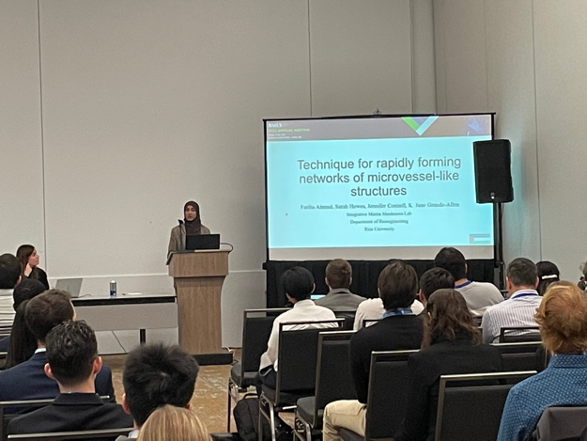Applying to BMES
This past spring, I submitted an application to present at my first national conference, the Biomedical Engineering Society (BMES) annual meeting, in Seattle, Washington, in October 2023. BMES is one of the biggest biomedical engineering conferences in the United States. As a bioengineering student, it seemed only natural that it would be the setting of my first conference experience. I started the application process by submitting an abstract, a short description of the significance, process, and findings of the scientific endeavor you want to present at the conference. I prepped and edited all of the materials, asking my Principal Investigator (PI) and other lab members to review what I had written; then, I submitted everything to my Specialty Track by the presentation deadline. Large conferences like BMES typically have “tracks” to organize the different abstracts into groups that have related topics. Doing this allows you to sit in an entire track session at the conference and watch oral presentations revolving around the same theme. Regarding deadlines, BMES (and other conferences) have a couple of abstract submission deadlines: for BMES, if you submit at the earliest deadline, you are eligible to give an oral presentation. After turning in my abstract in early May, I waited.
And I waited.
It was mid-July when I found out my abstract had been accepted!
Preparing for BMES
Once I found out my abstract had been accepted, I applied for a travel grant. Many schools–Rice included–offer these grants to defray costs for registration, travel, hotel costs, and sometimes even food during the conference. I applied for the Rice Institute for Biosciences and Bioengineering (IBB) travel grant, which I used to pay for registration ($500) and my flights ($400). Then, it was time to plan for my trip!
There were two things I needed to do to plan for the conference: 1) refine my presentation, including both my slide design and what I was going to say, and 2) make sure my wardrobe was all set.
To prepare for my presentation, I first created my slides, supplementing them with figures I had developed for a journal manuscript based on the same abstract. I practiced my slides multiple times, practicing with an audience of people with varying amounts of knowledge about my abstract. This allowed me to ensure it was understandable to people with various backgrounds.
I also wanted to make sure that I looked like a professional! I scoured the internet for timeless pieces that I could mix and match, looking for clothes that would keep me warm in the cooler Seattle weather while maintaining the aesthetic I was going for. I ended up pairing some older staple pieces I already had with some newer pieces from Old Navy (not sponsored) to create a few different outfits.
Going to BMES
Soon enough, it was time to go to Seattle. My PI encouraged my labmates and me to take some extra time to have fun traveling, so we left Texas a few days before the conference.
We spent the first half of our trip to Seattle visiting major attractions we had looked up before the trip. This included the iconic Pike Place Market, the Space Needle, the Chihuly Glass Garden, the Central Seattle Public Library, and riding a ferry to Bainbridge Island! We also spent much time trying out many coffee shops and brunch spots in downtown Seattle.



We spent more time at the conference during the second half of the week. BMES is a huge conference with tens of platform sessions, hundreds of presentations, and an entire hall dedicated to institutions, companies, and vendors interested in networking with students. I gave my talk on the first morning of the conference. While it was a little nerve-wracking, it felt great to answer questions related to the methods I presented. Looking back on it, I enjoyed the opportunity to develop an aesthetically pleasing slide deck that was rather seamlessly (if I do say so) tied to the interesting oral story I told. After giving my presentation, I was able to relax. I attended sessions where I could listen to forerunners in my field and others I was interested in (like DEI in engineering!).
I also watched my other lab members give oral/poster presentations. We capped off the BMES experience with BMES’s Reception Night. During Reception Night, many institutions reserve halls and invite people from other schools to network with faculty, students, and staff while providing entertainment and food.
Prepping for and attending BMES was an exciting experience that gave me a great introduction to presenting at conferences. As intimidating as it was to stand up in front of experts in my field, it was also incredibly rewarding. Additionally, getting the chance to travel with my lab was exciting and fun. Finally, while I had intellectually stimulating conversations based around science, presenting at conferences is also an important marker of progress, critical for fellowship and other applications. I recommend looking for conferences with themes related to your research! This will allow you to present and discuss your work with similar-minded people who can discuss and provide insights or may be curious to learn more and work with you.
About the author:
Fariha Ahmad is a current Ph.D. student in Bioengineering. She got her B.S. in Mechanical Engineering at the University of Texas - RGV. Read more.
Further Reading:
Getting Teaching Experience While in Grad School: Rice's Center for Teaching Excellence
Unleashing Productivity: Essential Technology and Tools for Grad Students
From Scholar to Startup: Navigating Entrepreneurship as a Ph.D. Student at Rice University

